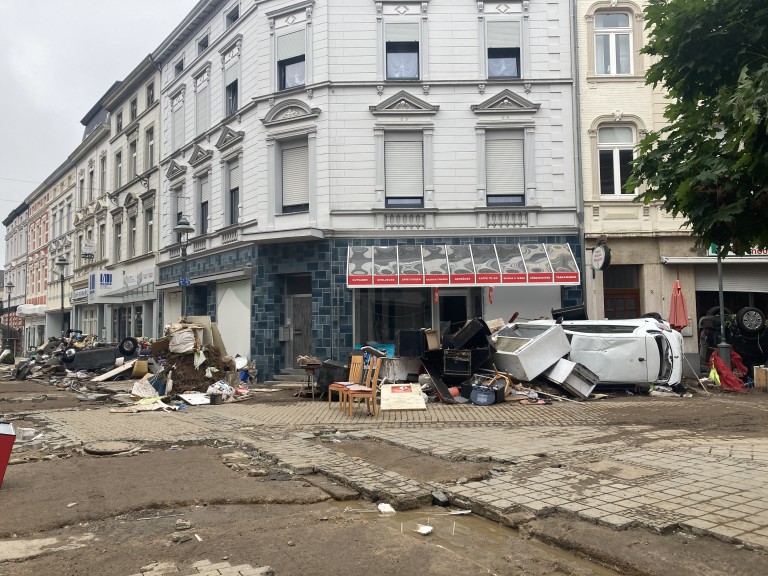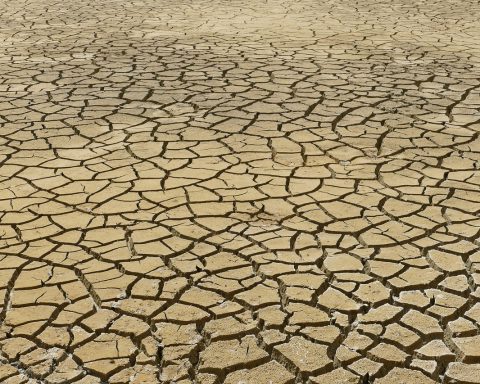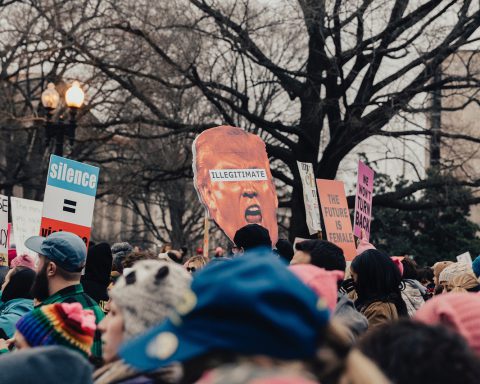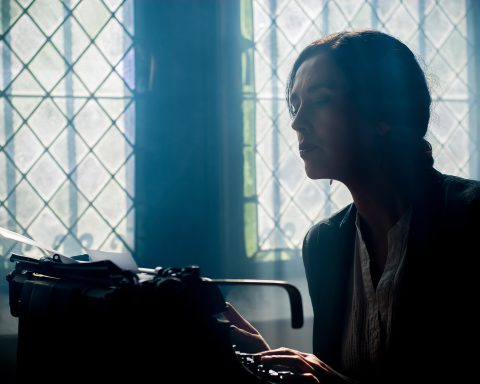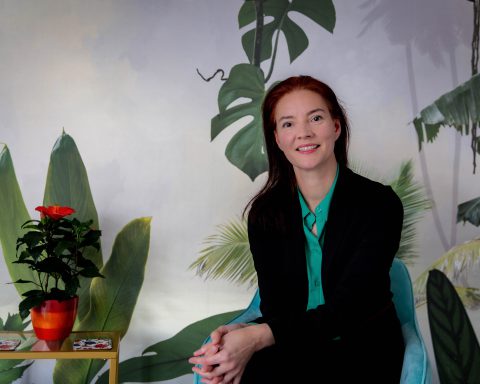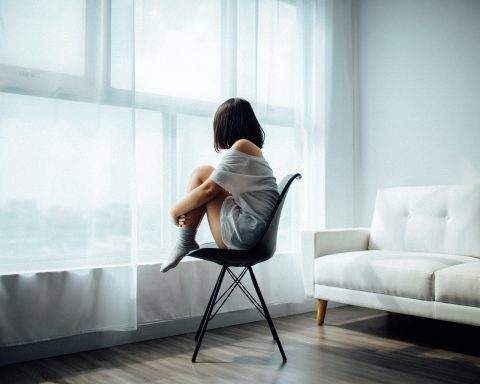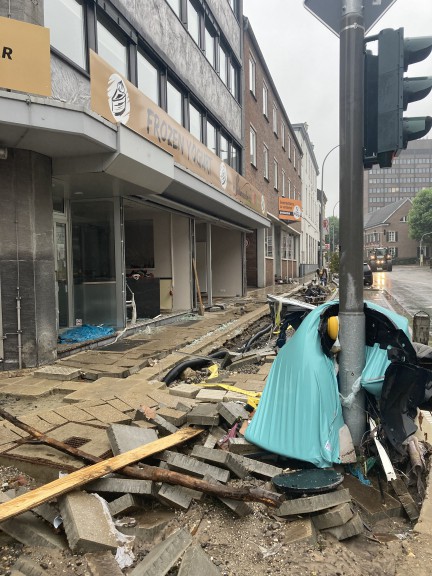
When I left Great Britain in March of last year to move to Germany, I was leaving behind a country on the verge of the worst pandemic it had ever seen. Now, a little over a year later, I am moving again. I am heading east to the city of Leipzig and leaving behind the small town of Stolberg in North-Rhine Westphalia, devastated after the worst flood in its history.
Wednesday last week started like any other morning. My husband and I had no idea what was about to unfold in the sleepy town we have called home for the last year. There was no warning of any flood, just a general weather forecast for rain that “might cause disruption,” which no one really pays any attention to, other than perhaps grabbing an umbrella before heading out the door.
Then, somewhere between 2 and 3 in the afternoon, we heard a loudspeaker from an emergency services vehicle announcing that there might be some flooding and not to go into the cellars.
This was the first awareness we had that there might be a flood.
We were nearly out of food, and though neither my husband nor I thought it likely we would be trapped in the apartment, I decided to walk to the shop, just in case. This was a little after 3 pm. The Aldi at the end of our street was closed as they were getting a new refrigeration system, and so I walked to Kaufland, which was the nearest supermarket.
Stolberg’s high street was fully open and there was no sign of any problem at this point. That was until I got closer to Kaufland. I could see the alley that I usually walked through was slightly flooded and not possible to pass.
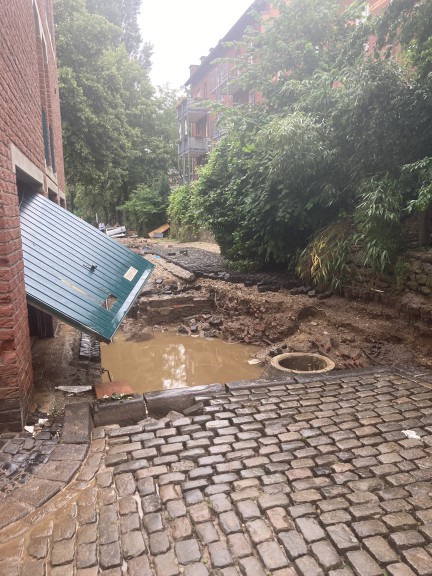
I carried on along the pavement to take a different way inside. The road was flooded a little here, but the pavements were clear. I was a bit more worried at this point, but as we needed food and I was already there, I went inside the supermarket, deciding to be very quick.
I was in the supermarket for less than thirty minutes, but even so, it was not possible to return the way I came. The street and pavement were flooded and cars and emergency vehicles were driving through the water creating waves over the pavement.
I felt very anxious about how I could get home, but then I remembered another route through the back of the car park.
The flood had not reached Zweifaller Straße and I felt relieved, though it meant a much longer walk back to our apartment.
I could see some river water starting to come through holes in the old wall by the river where stones had been displaced. I picked up my pace, heading up the hill by the Prym factory.
At this point I got a text from my husband, Benny: “The water is here,” it said. I wasn’t quite sure what this meant, but it didn’t sound good and so I phoned him. He told me he could see the water from our window coming up high street, and that it didn’t look too deep, but I would probably need to cross it.
We hung up and I walked faster down Aachener Straße, crossing to walk alongside the railroad and then over the footbridge that crossed the tracks just behind our local Aldi. I was relieved I could see no water there. I went down the steps and into the back of the shopping center.
When I came out onto the market square, there was a river flowing in front of me where the high street had been less than a couple of hours before.
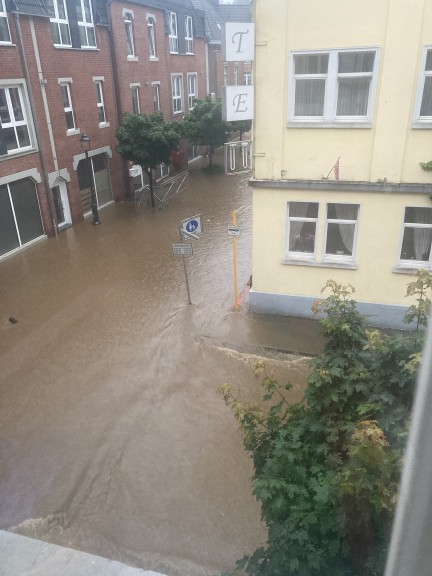
People were trapped on the steps by the Rathaus, and across at the local Eiscafé Rovere, and more people waited with me at the shopping center entrance. I didn’t know what to do. The water was very rapid.
Everyone around me seemed startled and to be contemplating the same problem, how to get home. A woman who stood on the steps of the Eiscafé crossed over toward me. She wobbled a bit, but made it safely across. The water was just below her knees. I figured I had to do the same.
I shakily walked into the water. It was cold, dirty and very strong, it felt like hands pulling my feet down. I got halfway and then I just froze, I was too frightened.
Luckily for me, a passerby saw me struggling and he waded in and helped me across. I thanked him and then walked the short distance home, trembling from fright and shock at just how fast this had all happened and how strange it all was.
My husband was relieved when I got home. I had a quick shower and threw my shoes in the bin.
We made coffee and from our kitchen window we saw an elderly man who lived in the senior center across our street. He got trapped by the flood waters and could not get to his home. We were relieved when a few moments later a man on the street picked him up and carried him safely into his home.
By this time the emergency services had cordoned off the river and the high street.
We heard them repeat the earlier message about staying out of the cellars. This was sometime around 5 pm. As we could see the water had not yet reached our house, we decided to try and move a few things up out of our cellar. By this time, it was around 5:30 pm.
The cellar was still dry when we got down and our landlord, who lives in the apartment beneath us, was already in the cellar. He asked us to close our window, which we did. I asked him if he thought it would flood down there and he said he thought probably it would not, as it had not before. We decided to remove our few possessions anyway, the bikes and some boxes. We had to leave the washing machine, but we raised it off the ground slightly and onto some sturdy plastic tubs.
Just as we finished this, we saw the water start to come up through the drain.
We collected a few last things and went back up to our apartment, where I reheated soup from the night before. Whilst we were eating, the light flickered and then went out. That was the last time we had electricity.
We spent most of that night watching the water rise in the river from our bedroom window, or the water on the street coming ever closer to our house from the kitchen window.
We had no radio, the mobile network was down, and so we had no idea what the advice was. There had been no more announcements from the emergency services. We talked about what we should do.
We packed a few things into bags in case we were evacuated. Our car had gone into the repair shop that morning, so we did not know how we could leave or where we could go. We decided to stay, and tried to sleep.
Around 1 am, my husband woke me up very distressed: He had seen a white car being carried past our home on the rapid flood waters.
It missed our walls, but landed upside down against the lamp post by the new corner shop at the end of our street. We looked out the window; it was dark, but we could see the waters very high and coming over the sides of the bridge.
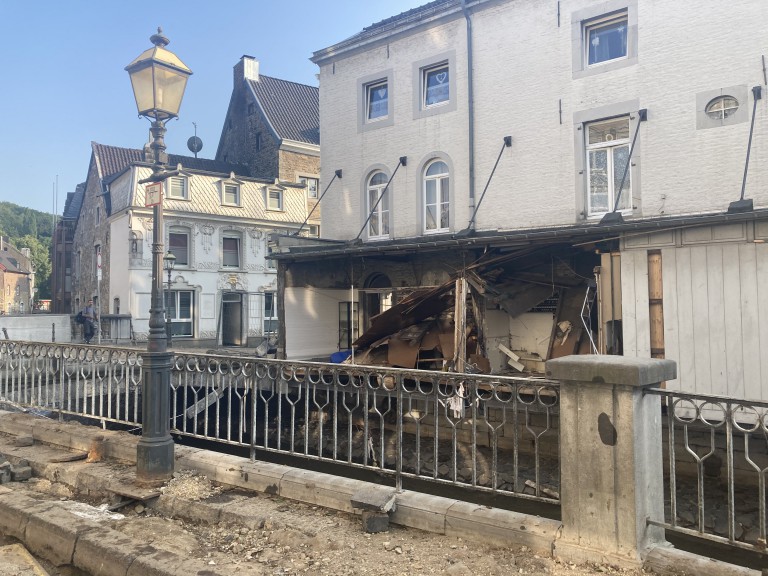
Just then, a group of young people came out of the car park behind our house and waded through the water before disappearing up the street. A fridge hit the wall of the bridge and the side of our neighbor’s house. It was spinning around in the water and constantly banging into the bridge and the wall of the house opposite.
My husband wanted to leave, but I was too frightened to go. We were surrounded by water and there were empty cars, fridges, and goodness knows what else being carried by the flood waters at some pace and force.
It was like a disaster movie, but real.
We tried to sleep, but didn’t really. In the morning I could see the water was all the way around us. It had come through the garden wall and into our backyard.
The water was right up to our walls. We were trapped.
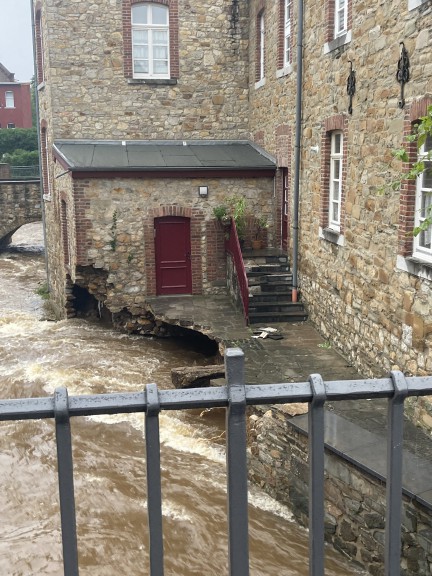
From our bedroom window, I could see that the garden patio and kitchen wall of the neighbor opposite had been eaten by the flood. They no longer had a patio, and the kitchen floor up to the window was completely gone. This was probably the most terrifying part, the feeling of helplessness, of being trapped, the realization of just how destructive the flood waters could be.
The view from the front window was no better; there were now two cars piled in front of the new corner shop and a rapid river flowing all around us and up the high street. No way out.
We put together the camping stove we had brought up from the cellar the night before and made some breakfast and a strong coffee. Luckily, we boiled the water, as we later learned that the water was contaminated.
From our kitchen window, we could see a few people in wellingtons carrying big bags. I wondered what they were doing, but then we saw a woman coming from the corner shop with a huge bag full of cigarettes and we realized that these people were looters. Some were trying the door handles to houses, probably looking to get inside and take what they could.
It is not enough misery that shops and people here have to face the mess, loss and destruction of the flood, now they also had to have what little was left taken from them by looters.
A few hours after breakfast, we could see that the flood waters were receding. A huge rush of relief. The rain came intermittently that morning and this allowed the water levels to sink. At some point in the morning, it had receded enough for us to venture into the yard. It was covered in mud.
Water covered the cellar steps, bins were upturned, and waste was in various places. I picked things up as best I could and swept the mud out of the gates and into the road. It was a bit better, at least.
Our landlords came out. They said they could get a pump for the cellar from the university where they worked and they would clean it with a jet wash as soon as they could borrow a generator. So we packed up the cleaning and decided to go for a walk.
We didn’t make it very far. The water had only receded enough so that we could get to the end of the road and back. It was enough to see a lot of damage, in the market square and also in the small residential square over the bridge behind our apartment. Everyone was trying to pump out their cellars and discard their dirty and damaged furniture.
Everyone looked shocked, tired, and frightened.
I saw my neighbor whose house had been eaten by the water. He just looked so angry and bewildered. There was a strong smell of oil and gas. We later learned there had been a gas leak on high street. I felt so helpless and so much sadness for what had happened and what it meant to the lives of everyone here in town.
I couldn’t understand how the flood could be this bad, happen this quickly and without any warning.
We went back home. By 2:30 in the afternoon, the water had receded back to high street: it was not as deep and not as fast flowing. We waited a little while longer and then ventured out again.
We made it further this time, down on to high street. We were completely stunned. There was rubble, cars, and massive holes in the road, pipes smashed and all the shops’ windows were shattered.
It was like there had been an explosion in every shop. It looked like a war zone.
There was not a single shop untouched by the flood. Everything was destroyed. The water had even got as high as the traffic lights and had brought them out of their sockets. The bridge on the road leading up to the hospital had a large tree wedged across it.

The local Café Sahneschnitte had only just reopened a few months back. During lockdown they invested in bigger premises and spent some time renovating. Now it was completely destroyed.
Just by the event location Kupferhof on Rathausstraße, the road had disintegrated and it was now just a hole with rubble and pipes mixed in. A policeman told us there had been a gas leak and they were trying to make the area safe again.
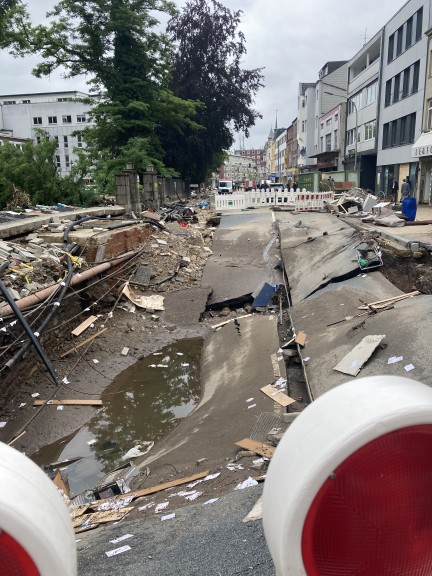
We asked if he knew anything about the utilities, and he didn’t. No one had any idea about what could be done at this point. He did tell us that he had heard they would release more water from the dams nearby again. We had already learned from Benny’s mum that the dam in Vicht had been opened the night before around midnight and that they released a three-meter-high wave that flooded Vicht, so this news was pretty frightening.
Back at our apartment the water was off. The landlord explained he needed a plumber as there was a leak. It took several days to fix this, so we were without both water and electricity at this point. We mentioned what the policeman had said about the dams to our landlord, but he explained that there were a lot of rumours.
A friend of his, who had something to do with managing the dams, had explained that, although they needed to release more water, it was going to be done only very gradually this time.
On Friday we went into the cellar and helped our landlord and neighbors to remove their items from there. It had taken a good while to pump out the water because the cellar door was wedged tight and could not be opened without a lot of force.
We spent most of the morning and some of the afternoon helping to remove the sodden cellar items. We also carried out our washing machine, which was beyond repair. After that we walked through the dusty town center and up to the garage to collect the car, so we could drive to nearby Aachen to pick up some more camping gas for the stove and a tow rope for the landlord, whose car had been damaged in the floods.
On Saturday morning we helped our landlord and neighbors to move all the damaged items from the side street into a big pile on the main street in front of our apartment to make it easier for the clean-up operation due to start in the coming days. The sun was shining and it was hard work but we soon had it all cleared between us.
Afterwards we drove to Eschweiler, though we soon had to turn back. It was hit just as hard as our town had been, and most of the roads were either closed or covered in rubble, damaged appliances, and furniture.
It seemed that every town and village on the river or near a dam had been struck. The devastation was unimaginable.
The town archives put out a call for volunteers, because they were trying to save as many of the towns’ records as possible, so I went and volunteered there. My German language skills are still not very good but I managed to get by well enough and the people in the archives were very grateful for the help. It was a big task. There were many documents to be carried up from the flooded cellar, dried out, and wrapped into clingfilm ready to be boxed.
A large number of volunteers worked side by side with the military and people from the council. It was a big effort and I am glad to have been a part of it.
I heard that Angela Merkel chose to visit Schuld, a small village that had been badly hit by the floods. I wondered if this was a deliberate act on her part as the word Schuld means “guilt.” She made a statement shortly after her visit that Germany must make a greater effort in tackling climate change.
Germany is supposed to have an early warning system for this kind of natural disaster, but now there are over 165 deaths. We never had any warning and I doubt that many of the other people did. A system has failed when people are left this vulnerable, in unsafe houses without clean water, electricity, or means of communication.
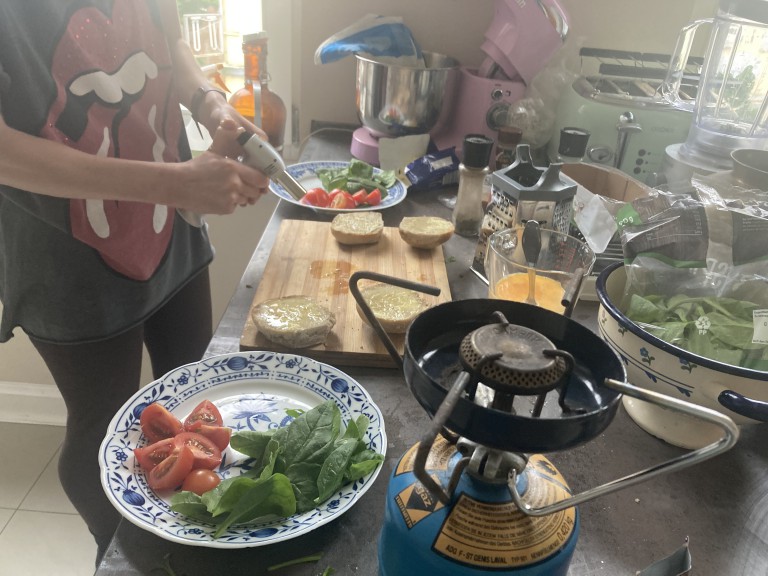
One morning this week, I went out for a walk and saw a pile of dead baby rats. I presumed they must have washed up in the flood, drowned. I wondered how many other animals have been lost to this flood; probably lots. I thought of a poster I had seen a few weeks before of someone searching for their family’s cat. I hoped they had found it.
The town of Stolberg was already struggling before COVID-19, and a few places had shut up shop permanently due to the pandemic.
After this, I wonder if anyone will want to try again, or if they even could, having lost so much. I hear they had to evacuate the local hospital, and some doctors closed, too. I wonder if hospitals and doctors in other affected places are closed. It’s a hell of a time to be without a hospital in your hometown.
It has now been over a week and the drinking water is still contaminated, the electricity is still out. I think it will take years to repair all the damages here, if complete repair is actually possible. I wonder if the electricity will even be back before we move out at the end of next month.
I don’t like taking a cold shower. But then I look out the window, any of the windows here in our apartment, and I realize things could be a lot, lot worse.

